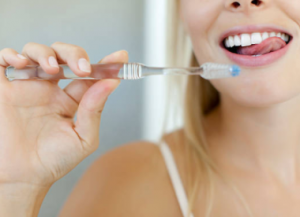How to brush your teeth – the right way!
Step 1: Choose the right toothbrush! A soft toothbrush is always the best choice. It must be capable of effectively removing plaque and debris from your teeth without doing any long-term damage to your gums. Your toothbrush of choice, must sit comfortably in your hand and have a small enough head to help it clean all those hard to reach places.
– Electric Toothbrushes are great if you feel that it would encourage you to spend more time on your teeth; however, a manual toothbrush can achieve just as good results – it’s all depending on the technique.
– When it comes to toothbrushes that are labelled “natural”, these should definitely be avoided as they need replacing far more regularly due to the fact that can be harbour bacteria.
Step 2: Replace your toothbrush regularly. Your toothbrush will eventually wear down and lose its flexibility. Don’t wait for this to happen! Replace your toothbrush every 3-4 months and your oral health will thank you.
– Always rinse your toothbrush after using it, and store it uncovered and upright so that it has a chance to dry before you use it again. When left lying down or covered up straight after usage, bacteria has a greater chance to start growing.
Step 3: Use a fluoride toothpaste as it helps remove plaque, and helps strengthen your tooth enamel.
– Fluoride toothpaste should not be ingested as it can lead to serious health problems and children under the age of 3 must not use it also.
– Ask your dentist on advice on what toothpaste best suits the needs of your oral health.
Step 4: Use dental floss or an interdental brush or both. Flossing your teeth is equally as important as brushing them but yet many people skip this part of their morning and nightly routine. Flossing removes plaque build ups, bacteria and particles of food that become lodged in between your teeth. Your toothbrush will never do as good of a job as floss will. Flossing before brushing will help remove any bits of food or bacteria that remain in the mouth after flossing.
– Floss gently and don’t snap floss between the teeth as this can irritate the gums.
– Ease the floss gently between the teeth, following the curve of the tooth.
Now that you’ve learnt about the particulars of tooth brushing, we must now learn how to use these tools.
Step 1: Add a small amount of toothpaste to your brush. Adding too much toothpaste can cause over-sudsing and tempt you to finish brushing earlier.
– If brushing is in any way painful, try brush more gently and accurately with up and down motions or switch to a toothpaste formulated for sensitive teeth.
Step 2: Set your toothbrush bristles at the gum line at a 45-degree angle. Gently begin to brush with a short vertical or circular motion. Work on one to two teeth at a time.
– The same technique is applied to platal/lingual surfaces (underneath).
Keep applying the same technique for each section of your mouth. Not forgetting behind the teeth also.
It should take you from between 2 to 2.30 minutes to brush your teeth. Try dividing your mouth into quadrants, each one taking around 30 seconds to brush, you will find that by doing so, you are making sure that each quadrant gets the same time and care as the other.
When it comes to the tongue, a gentle brush with the bristles on your is necessary as it removes bacteria and helps keep bad breath away. Brush gently and be careful not to press too hard as this can damage your tongue tissue.
Now that you have finished brushing your teeth and tongue, it is time to:
Step 1: Rinse your mouth of toothpaste. Use water and swish it around your mouth and spit it out when you feel you are satisfied.
Step 2: Rinse your toothbrush thoroughly to ensure that there is no bacteria remaining on your brush for the next time. Remember to place your toothbrush in a place where it can get the best chance to fully dry out.
Step 3: Finish your routine with mouthwash. Take a small sip and swirl around your mouth for around 30seconds and always spit it out.
Finally… remember to brush your teeth at least twice a day. Most dentists will recommend brushing once in the morning and once before bed.
Try avoiding over-brushing as this can cause other gum related problems. The key is to find the perfect balance for you.
Your dentist or hygienist will always be ready to give the best advice for your oral health.


